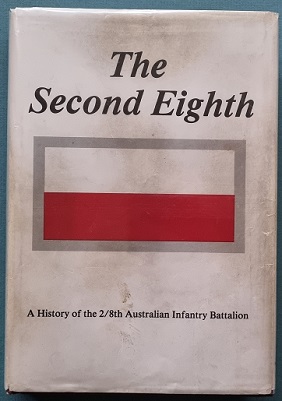Description
Title: 24th Australian Infantry Battalion AIF – Pictorial Battle History
Author: N/A
Condition: Very Good Plus – over a little ragged at edges and a couple of small tears.
Edition: 1st Edition
Publisher: The Battalion
Publication Date: 1946
ISBN: N/A
Cover: Soft Cover with Dust Jacket – 63 pages.
Comments: A pictorial history of the 24th Infantry Battalion during World War 2.
After the First World War the defence of the Australian mainland lay with the part-time soldiers of the Citizens Military Force, otherwise known as the Militia. The Militia was organized to maintain the structure of the First AIF and kept the same numerical designations. These Militia units were also distributed in the same areas that had raised the original AIF units. Consequently, Militia units were also known by the name of their shire. Thus, Victoria’s 24th Infantry Battalion was the “Kooyong Regiment”, headquartered in Surrey Hills in Melbourne. The battalion had training establishments in Camberwell, Box Hill, Upper Hawthorn, and Ringwood. A company was also formed at Belgrave with detachments at Ferntree Gully and Lilydale. In June 1939 the 24th was merged with the 39th Infantry Battalion, forming the 24th/39th Infantry Battalion. Along with the 37th and 52nd Battalions, the 24th/39th was part of the 10th Brigade of the 3rd Division.
With the outbreak of the Second World War, the 24th/39th held a number of training camps, first at Trawool and then, from December 1940 and throughout 1941, at Nagambie Road, north of Seymour in Central Victoria. In February 1941 the 24th/39th split and reverted to again being two separate battalions. The 39th went to the newly formed 30th Brigade.
In May 1942 the 24th was transferred to Queensland where it undertook further training. In September the 10th Brigade was disbanded and the 24th joined the 57th/60th and 58th/59th Battalions of the 15th Brigade.
After years of training, the 3rd Division moved to New Guinea in 1943. The first group from the 24th sailed to Port Moresby in February, while the last group arrived in April. The division’s destination was the Lae–Salamaua front. At the end of April, the 24th was flown to Wau to join the Kanga Force. The rest of the 15th Brigade followed, with the 58th/59th arriving at the end of May and the 57th/60th in mid-June. The brigade covered a vast track of jungle. The 58th/59th faced the Japanese positions along Bobudi Ridge, while the 24th defend the Wampit Valley against Japanese infiltrators from Bulolo. The 24th also protected the airstrips at Bulwa and Zenag. The 57th/60th did not participate in the assault on Salamaua but was instead sent to protect the American airbase at Tsili Tsili.
On 4 September the Allied offensive against Lae began. In support of this attack and in order to confuse the Japanese, the 24th patrolled from the Wampit Valley towards the Markham River. Lae fell to the Australians on 16 September, while Salamaua had been occupied on 11 September. However, there was little respite for the 24th, as it moved to Nadzab in October.
In early 1944 the 15th Brigade returned to the front, this time to Dumpu in the Ramu Valley, under the command of the 7th Division. The brigade supported the clearing of the Ramu Valley and the advance on Madang, which was captured on 24 April. After all most a year-and-a-half in New Guinea, the 15th Brigade finally returned to Australia in August. Gavin Long later commented that with its extensive service, the brigade had marched over more of New Guinea than any other Allied formation.
After some leave, the brigade regrouped in the Atherton Tablelands in Queensland in October. Unlike many other units, though, theirs was only a brief stay. The 3rd Division had already moved to Bougainville and the brigade followed.
In Bougainville’s Southern Sector, the 15th Brigade took over from the 7th Brigade in mid-April 1945. In order to continue the Australian advance to Buin, the 15th Brigade advanced on a two-battalion front. One battalion followed the Commando Road, known as the North axis, while the other battalion followed the Buin Road, the South axis. Taking up a position at Kero Creek, the 24th was in the lead, with the 58th/89th behind at Barara. On 17 April the 24th opened the brigade’s attack by crossing Dawe’s Creek. Although shelled regularly and withstanding a Japanese counter-attack at Sindou Creek, by 7 May the 24th had reached the Hongoria River. The 57th/60th, moving along the Commando Road, also reached the river. The 24th was then joined by the 58th/59th. During the “battle of the rivers” both battalions advanced along the Buin Road until they reached the Mivo River at the end of June. The 15th Brigade was relieved by the 29th Brigade on 1 July.
With the war over, the ranks of the 24th thinned, as men were discharged or transferred. On 3 December the 24th sailed for Australia on the transport Canberra and arrived at Townsville on 7 December. The battalion was disbanded on 19th January 1946.
Includes Nominal Roll





